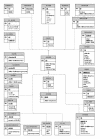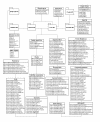SeqHound: biological sequence and structure database as a platform for bioinformatics research
- PMID: 12401134
- PMCID: PMC138791
- DOI: 10.1186/1471-2105-3-32
SeqHound: biological sequence and structure database as a platform for bioinformatics research
Abstract
Background: SeqHound has been developed as an integrated biological sequence, taxonomy, annotation and 3-D structure database system. It provides a high-performance server platform for bioinformatics research in a locally-hosted environment.
Results: SeqHound is based on the National Center for Biotechnology Information data model and programming tools. It offers daily updated contents of all Entrez sequence databases in addition to 3-D structural data and information about sequence redundancies, sequence neighbours, taxonomy, complete genomes, functional annotation including Gene Ontology terms and literature links to PubMed. SeqHound is accessible via a web server through a Perl, C or C++ remote API or an optimized local API. It provides functionality necessary to retrieve specialized subsets of sequences, structures and structural domains. Sequences may be retrieved in FASTA, GenBank, ASN.1 and XML formats. Structures are available in ASN.1, XML and PDB formats. Emphasis has been placed on complete genomes, taxonomy, domain and functional annotation as well as 3-D structural functionality in the API, while fielded text indexing functionality remains under development. SeqHound also offers a streamlined WWW interface for simple web-user queries.
Conclusions: The system has proven useful in several published bioinformatics projects such as the BIND database and offers a cost-effective infrastructure for research. SeqHound will continue to develop and be provided as a service of the Blueprint Initiative at the Samuel Lunenfeld Research Institute. The source code and examples are available under the terms of the GNU public license at the Sourceforge site http://sourceforge.net/projects/slritools/ in the SLRI Toolkit.
Figures




Similar articles
-
Atlas - a data warehouse for integrative bioinformatics.BMC Bioinformatics. 2005 Feb 21;6:34. doi: 10.1186/1471-2105-6-34. BMC Bioinformatics. 2005. PMID: 15723693 Free PMC article.
-
GeneTools--application for functional annotation and statistical hypothesis testing.BMC Bioinformatics. 2006 Oct 24;7:470. doi: 10.1186/1471-2105-7-470. BMC Bioinformatics. 2006. PMID: 17062145 Free PMC article.
-
Windows .NET Network Distributed Basic Local Alignment Search Toolkit (W.ND-BLAST).BMC Bioinformatics. 2005 Apr 8;6:93. doi: 10.1186/1471-2105-6-93. BMC Bioinformatics. 2005. PMID: 15819992 Free PMC article.
-
Computational sequence analysis revisited: new databases, software tools, and the research opportunities they engender.J Lipid Res. 1992 Jul;33(7):957-74. J Lipid Res. 1992. PMID: 1431588 Review.
-
Bioinformatic Approaches for Characterizing Molecular Structure and Function of Food Proteins.Annu Rev Food Sci Technol. 2023 Mar 27;14:203-224. doi: 10.1146/annurev-food-060721-022222. Epub 2023 Jan 9. Annu Rev Food Sci Technol. 2023. PMID: 36623922 Review.
Cited by
-
Atlas - a data warehouse for integrative bioinformatics.BMC Bioinformatics. 2005 Feb 21;6:34. doi: 10.1186/1471-2105-6-34. BMC Bioinformatics. 2005. PMID: 15723693 Free PMC article.
-
DiscoverySpace: an interactive data analysis application.Genome Biol. 2007;8(1):R6. doi: 10.1186/gb-2007-8-1-r6. Genome Biol. 2007. PMID: 17210078 Free PMC article.
-
PreBIND and Textomy--mining the biomedical literature for protein-protein interactions using a support vector machine.BMC Bioinformatics. 2003 Mar 27;4:11. doi: 10.1186/1471-2105-4-11. Epub 2003 Mar 27. BMC Bioinformatics. 2003. PMID: 12689350 Free PMC article.
-
BIND: the Biomolecular Interaction Network Database.Nucleic Acids Res. 2003 Jan 1;31(1):248-50. doi: 10.1093/nar/gkg056. Nucleic Acids Res. 2003. PMID: 12519993 Free PMC article.
-
ArrayPlex: distributed, interactive and programmatic access to genome sequence, annotation, ontology, and analytical toolsets.Genome Biol. 2008;9(11):R159. doi: 10.1186/gb-2008-9-11-r159. Epub 2008 Nov 12. Genome Biol. 2008. PMID: 19014503 Free PMC article.
References
-
- Schuler GD, Epstein JA, Ohkawa H, Kans JA. Entrez: molecular biology database and retrieval system. Methods Enzymol. 1996;266:141–162. - PubMed
Publication types
MeSH terms
LinkOut - more resources
Full Text Sources

